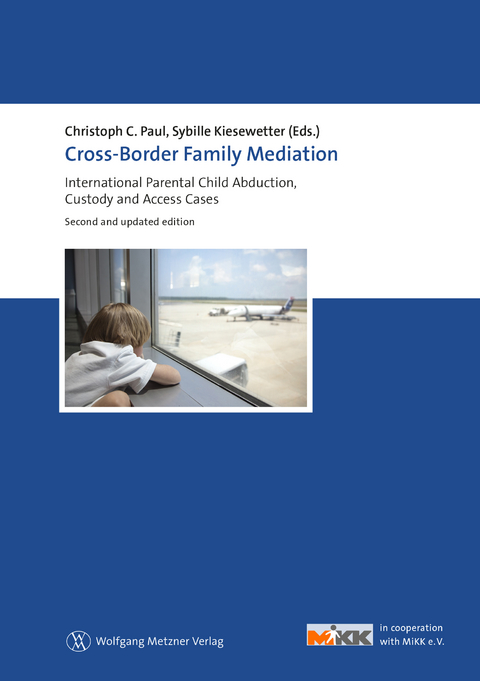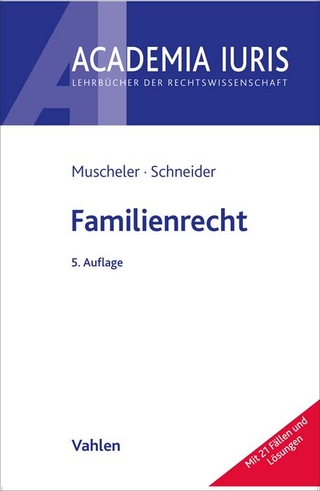Cross-Border Family Mediation
Wolfgang Metzner Verlag
978-3-943951-15-8 (ISBN)
- Titel erscheint in neuer Auflage
- Artikel merken
Übersicht der relevanten Literatur
Einblick in die spezifischen Charakteristika grenzüberschreitender Mediation
Informationen darüber, wie Mediation in grenzüberschreitenden Sorgerechtsverfahren eingebunden werden kann
Methoden und Werkzeuge für Mediation in grenzüberschreitenden Familienkonflikten
Fallstudien
Hilfestellung für den Umgang mit Mehrsprachigkeit, interkulturellen Aspekten und verschiedenen Mediationsperspektiven.
Praxisbezogene Muster und Informationsblätter für Eltern, Anwälte und Richter machen das Buch zu einem wertvollen Handwerkszeug für Mediatoren und alle anderen Professionen im Umfeld grenzüberschreitender Familienmediation.
Christoph C. Paul ist seit 1978 als Rechtsanwalt und Notar tätig. Seit 1995 ist er Mediator (BAFM). Er arbeitet als Mediator in eigener Praxis in den Bereichen der Familien- sowie Erb- und Wirtschaftsmediation und ist spezialisiert auf Mediationen bei internationalen Kindesentführungen sowie internationalen Umgangs- und Sorgerechtsverfahren. Von 1999 bis 2011 war er Sprecher der Bundes-Arbeitsgemeinschaft für Familienmediation (BAFM) und ist heute Vorsitzender „MiKK e.V. International Mediation Centre for Family Mediation and Child Abduction“. In den letzten zwei Jahren war Christoph C. Paul Mitglied der Expertengruppe Vorbereitung der Gesetzgebungsarbeiten für ein Mediationsgesetz beim Bundesministerium der Justiz. Er hat diverse Beiträge aus dem Bereich der Mediation publiziert, insbesondere zur Stellung des Rechtes im Mediationsverfahren sowie zu Fragen der Internationalen Mediation. Christoph C. Paul wurde wegen seines ehrenamtlichen Engagements um die Implementierung von Mediation bei internationalen Kindschaftskonflikten mit dem Verdienstkreuz am Bande der Bundesrepublik Deutschland ausgezeichnet. 2010 erhielt er als langjähriger praktizierender Mediator und als »Mediator der Mediation« in institutionellen Zusammenhängen den Sokrates- Preis für Mediation.
Sybille Kiesewetter ist Dipl.-Psychologin und Mediatorin. Seit 2006 ist sie freiberuflich als Mediatorin, Trainerin, Supervisorin und Beraterin tätig. Schwerpunkte ihrer Arbeit sind Konzeptentwicklung und Lead Trainerin verschiedener (EU-)Projekte, wie z.B. Trainerin für MiKK e.V., „Training in International Family Mediation“, „LEPCA – Lawyers in Europe on Parental Child Abduction“, Trainerin zusammen mit E. Carl des austr.-jap. Familienmediationsprojektes in Japan und Trainerin für “Emotionalität in der anwaltlichen Praxis”.
Table of Contents
Acknowledgements 9
Foreword 11
Section 1 The Bigger Picture 17
The Legal Framework of Child Abduction Cases Kyra Nehls 19
1. Introduction 19
2. The legal framework of the Hague Convention on the Civil Aspects of International Child Abduction
(1980 Hague Convention) 19
2. 01 Scope 19
2. 02 Substantive requirements for return 20
2. 03 Ban on a decision on the merits of custody rights (art 16) 21
2. 04 Exceptions from the obligation to return the child
immediately 21
2. 05 Procedural steps 23
2. 06 Special features of the Brussels II bis Regulation 24
2. 07 De-escalation measures to end proceedings 25
3. European Convention on Recognition and Enforcement of Decisions Concerning Custody of Children and on Restoration of Custody of Children (European Custody Convention) 27
4. Abductions in Contracting States not party to the 1980 Hague Convention 28
5. International rights of custody and access 28
5. 01 Brussels II bis Regulation 29
5. 02 Hague Convention Concerning the Powers of Authorities and the Law Applicable in Respect of the Protection of Infants (1961 Hague Convention) 31
5. 03 Hague Convention of 19 October 1996 on Jurisdiction, Applicable Law, Recognition, Enforcement and
Co-operation in Respect of Parental Responsibility and Measures for the Protection of Children
(Hague Child Protection Convention) 31
5. 04 Access rights under the 1980 Hague Convention 33
5. 05 Rights of access under the European Convention on Recognition and Enforcement of Decisions Concerning Custody of Children and on Restoration of Custody and Children 34
5. 06 Convention on Contact Concerning Children (Contact Convention) 34
5. 07 Autonomous law 34
6. Conclusion 36
7. References 36
Family Mediation in an International Context Sybille Kiesewetter & Christoph C Paul 37
1. Cross-border parental child abduction and access conflicts 37
2. Challenges of mediating cross-border disputes involving parents and children 37
2. 01 Putting mediation on the agenda 37
2. 02 Suitability for mediation 38
2. 03 Particularities of mediation in 1980 Hague Convention cases 39
2. 04 Finding suitable mediators 40
2. 05 Motivating parents and lawyers 41
2. 06 Preparing the mediation process 42
2. 07 Time needed in the preparatory stage 44
2. 08 Location of the mediation 44
2. 09 Timeframe of the mediation 45
2. 10 Particular features related to the stages of mediation 46
2. 11 Who else should be involved in the mediation? 47
2. 12 Collaboration of the co-mediators 48
2. 13 How should the lawyers of both parents be integrated? 49
2. 14 How should the courts be integrated? 50
2.15 Particularities in relation to the mediation process 51
2. 16 Language, communication, documents, resources 51
2. 17 Agreement to mediate 52
2. 18 Fees and expenses 53
2. 19 Final agreement 53
2. 20 Post-mediation care and support 53
3. References 54
Integrating Mediation into Court Proceedings in.Cross-border Family Cases
Eberhard Carl & Martina Erb-Klünemann 57
1. Introduction 57
2. Court proceedings for the return of the child 57
3. Advantages to integrating mediation 60
4. Integrating mediation into court proceedings 61
4. 01 Working groups 62
4. 02 German working group recommendations 63
4. 03 Further considerations when recommending mediation 64
5. Financing mediation 67
5. 01 Statement of costs 68
6. Integrating results of mediation into court proceedings 70
7. Cross-border parental responsibility and contact proceedings 72
8. Conclusion 73
9. References 73
Mediation in Action Eberhard Carl & Jamie Walker 75
1. Introduction 75
2. The challenges of mediating cross-border family conflicts 75
3. Making the best of an “impossible” situation 76
4. Methodology, dynamics and attitude 78
5. Case studies 81
5. 01 Adam 81
5. 02 Felix 83
6. Bi-national projects and wider international cooperation 84
6. 01 Developing professional mediation: The German-French project 85
6 02 Dealing with different legal cultures:
The German-American project 87
6. 03 Cooperation at all levels: The German-Polish project 89
6. 04 Towards broader international cooperation 91
7. Conclusion 92
8. References 93
Cross-border Child Abduction Mediation in Cases concerning Non-Hague Convention Countries
Mohamed M Keshavjee 95
1. Introduction 95
2. Background to the topic 96
2. 01 The 1980 Hague Convention 97
2. 02 The 1980 Hague Convention – its principles and shortcomings 98
2. 03 Mediation in different cultures and traditions 99
2. 04 The Sharia position with regard to child abduction 100
2. 05 Amenability of international parental child abduction to mediation in Islam 101
2. 06 Challenges: Attitude and structure 103
2. 07 Making mediation an attractive and viable option 104
2. 08 Auxiliary support mechanisms for effective mediation 104
2. 09 The Malta Process: Working Party on cross-border family mediation of the Hague Conference 106
2. 10 Need for shared understanding at an international level 107
2. 11 Essential elements of required training 109
2. 12 Culturally appropriate model 110
2. 13 The reunite experience: The pilot project 110
2. 14 The information base on Muslim countries 111
2. 15 Incremental learning – a way forward 111
3. References 112
Many Countries, Many Mediating Customs Hansjörg Schwartz & Felix Wendenburg 115
1. Introduction 115
2. Mediator orientations as described by Leonard L Riskin 116
2. 01 Basic Model 116
2. 02 New Model 116
3. Particularities of international child custody cases that may
influence the mediator’s decision-making strategy 118
3. 01 Distrust of the foreign legal system 118
3. 02 Strong involvement of legal authorities and other bodies 119
3. 03 Linguistic and cultural differences 119
3. 04 Immense time pressure, long distances 119
3. 05 Distinct mutual distrust 120
3. 06 Great public attention 120
3. 07 Substantial commitment of the support systems 120
3. 08 Lacking awareness of the parental roles 121
4. Co-mediations in international child custody cases 121
4. 01 International mediation style differences 122
4. 02 Lacking number of joint experiences 122
4. 03 Little time to prepare 122
4. 04 Language issues 123
4. 05 Stereotypes vis-à-vis mediators from a different country 123
4. 06 How to proceed constructively in international co-mediations 123
5. Conclusion 124
6. References 124
Cross-border and Bilingual:.Bridging the Linguistic Gap
Mary Carroll 125
1. Introduction 125
2. Parties in conflict 126
3. Complex problem: Clear-cut solution? 127
3. 01 Intercomprehension 128
3. 02 The co-mediator as interpreter 128
3. 03 From a triad to a quadrant – enlisting an interpreter 130
4. Role plays and interviews 134
5. Conclusion 135
5. 01 Suggestions for mediators of bilingual cross-border mediations 135
6. References 138
Section 2 Tools, Laws and Guidelines 139
1. Contacts 141
2. 1980 Hague Convention 142
3. Brussels II bis Regulation 155
4. Wroclaw Declaration 184
5. Links to other useful documents 186
5. 01 Declaration of the Malta Conference 186
5. 02 Guide to good practice under the 1980 Hague Convention 186
5. 03 Guide to Good Practice on Mediation 186
5. 04 EU Directive on Certain Aspects of Mediation 186
6. Prevention Guides 187
6. 01 Centrum IKO: Prevention guide 187
6. 02 Child Focus: Prevention guide 187
6. 03 MiKK: Prevention guide (in German) 187
6. 04 reunite: Prevention guide 187
7. International Mediation Laws 187
8. Checklists 188
8. 01 Checklist for requirements for an order of return 188
8. 02 Procedural checklist for judges 189
9. Court information letters 191
9. 01 Information for conflict parties: An example
from Germany 191
9. 02 Information for Lawyers: An Example from Germany 193
10. Agreement to Mediate 196
11. Stages of mediation 199
12. Examples of mediated parental agreements 200
12. 01 Parental settlement and court order – Germany 200
12. 02 Parental settlement and court order – USA 203
Section 3 Case Studies 207
A Bangladeshi-British Mediation Mohamed M Keshavjee 209
The Role of Consulting Lawyers Christoph C Paul & Jamie Walker 215
From Child Abduction to Property Distribution Christoph C Paul & Jamie Walker 223
Notes on Contributors 233
List of Authors 240
| Erscheint lt. Verlag | 6.8.2014 |
|---|---|
| Sprache | englisch |
| Maße | 148 x 210 mm |
| Gewicht | 321 g |
| Einbandart | Paperback |
| Themenwelt | Schulbuch / Wörterbuch ► Lexikon / Chroniken |
| Recht / Steuern ► EU / Internationales Recht | |
| Recht / Steuern ► Privatrecht / Bürgerliches Recht ► Familienrecht | |
| Schlagworte | agreement to mediate • Child abduction • Christoph C. Paul • Cross Border Family Mediation • Familienkonflikt • Familienmediation • grenzüberschreitene Mediation • interkulturelle Mediation • International mediation • Mediation • Mediationmediation laws • Mediation mit Mehrsprachigkeit • parental agreements • sorgerechtsverfahren • Sybille Kiesewetter |
| ISBN-10 | 3-943951-15-4 / 3943951154 |
| ISBN-13 | 978-3-943951-15-8 / 9783943951158 |
| Zustand | Neuware |
| Informationen gemäß Produktsicherheitsverordnung (GPSR) | |
| Haben Sie eine Frage zum Produkt? |
aus dem Bereich





